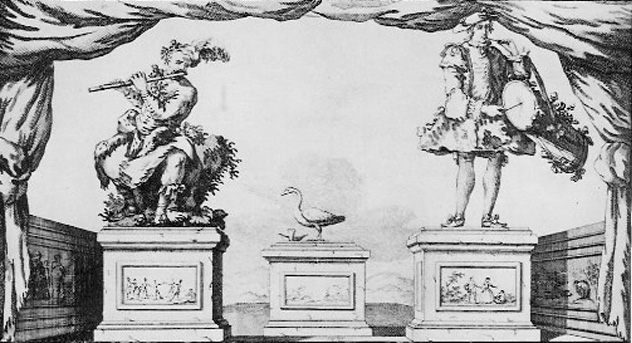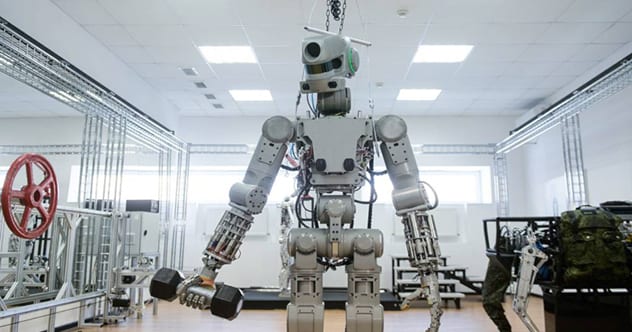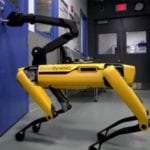 Technology
Technology  Technology
Technology  Humans
Humans 10 Everyday Human Behaviors That Are Actually Survival Instincts
 Animals
Animals 10 Animals That Humiliated and Harmed Historical Leaders
 History
History 10 Most Influential Protests in Modern History
 Creepy
Creepy 10 More Representations of Death from Myth, Legend, and Folktale
 Technology
Technology 10 Scientific Breakthroughs of 2025 That’ll Change Everything
 Our World
Our World 10 Ways Icelandic Culture Makes Other Countries Look Boring
 Misconceptions
Misconceptions 10 Common Misconceptions About the Victorian Era
 Mysteries
Mysteries 10 Strange Unexplained Mysteries of 2025
 Miscellaneous
Miscellaneous 10 of History’s Most Bell-Ringing Finishing Moves
 Technology
Technology Top 10 Everyday Tech Buzzwords That Hide a Darker Past
 Humans
Humans 10 Everyday Human Behaviors That Are Actually Survival Instincts
 Animals
Animals 10 Animals That Humiliated and Harmed Historical Leaders
Who's Behind Listverse?

Jamie Frater
Head Editor
Jamie founded Listverse due to an insatiable desire to share fascinating, obscure, and bizarre facts. He has been a guest speaker on numerous national radio and television stations and is a five time published author.
More About Us History
History 10 Most Influential Protests in Modern History
 Creepy
Creepy 10 More Representations of Death from Myth, Legend, and Folktale
 Technology
Technology 10 Scientific Breakthroughs of 2025 That’ll Change Everything
 Our World
Our World 10 Ways Icelandic Culture Makes Other Countries Look Boring
 Misconceptions
Misconceptions 10 Common Misconceptions About the Victorian Era
 Mysteries
Mysteries 10 Strange Unexplained Mysteries of 2025
 Miscellaneous
Miscellaneous 10 of History’s Most Bell-Ringing Finishing Moves
10 Amazing Robots Built Without Modern Technology
The word “robot” was first coined by Karel Capek in the sci-fi play R.U.R. (“Rossum’s Universal Robots”) to describe an artificial human. It is derived from the Czech word robotnik, meaning “worker.”
Modern robots have kept pace with the digital revolution and advances in artificial intelligence. But basic analog mechanisms that mimic human or animal actions have a long history. Even if you have little or no interest in robotics, these ancient devices mesmerize with their ingenuity. Designed without the benefit of electricity or precision equipment, they are a testament to humanity’s boundless creativity.
10The Moving Statues

Ancient literature is replete with tales of artificial humans. Prominent among these are references to android serving girls in Homer’s Iliad and moving statues crafted by Daedalus, father of the legendary Icarus. The Greeks also relate that the god Hephaistos gave King Minos of Crete a giant metal man named Talos, who defended his kingdom. Talos was nearly indestructible, and its only vulnerability was its ankle, where a pipe carrying fluid ran close to the metal skin. Talos was destroyed when the ankle was punctured and the pipe was cut.
Stories of moving statues in ancient Egypt include one made by priests of Ammon around 1100 B.C. It reportedly chose the next pharaoh by stretching out its arm and selecting a male member of the royal family. Moving statues were obviously very useful as religious propaganda. In Egypt, they were considered the vessels through which the soul was reincarnated.
These machines may have been more than myth. Written documents reveal that ancient Egyptians had enough knowledge of elementary principles of mechanics to build non-digital robots, or automata. The usual method employed an elaborate system of ropes and pulleys. A sacred flame would be lit, heating and expanding the air, thus activating the system.
This process was further developed and refined through the centuries. The Greek Ctesibius of Alexandria built an automaton operated by cams (disc-shaped devices) enabling it to sit or stand as it was moved in a procession. None of Ctesibius’s writings survive, but later ancient engineers refer to his plans for automata powered by hydraulics, steam, and pneumatics. The technology of the age only allowed for limited, repetitive motion, but we can still trace the origin of robots to Ctesibius.
9The Claw
Strictly speaking, Archimedes’s crane-like weapon was not a robot because it needed a crane operator. But the Claw was a precursor to the industrial robotic arm found in modern factories. The Claw lifted enemy ships bodily out of the water and overturned them.
It was employed against the Roman invaders of Syracuse in 213 B.C. The historian Polybius recounted the scene as the Roman ships approached the city’s seaward-facing walls. The giant hand swooped down on a target vessel and “lifted the ship’s prow out of the water and stood it up vertically on its stern.” Then the operator “fastened the machine to make it immovable, and then by some sort of release mechanism, cast off the grappling hook and chain. The ships then either capsized, listed badly, or became filled with confusion and much seawater.”
Plutarch adds, “Often there would be seen the terrifying spectacle of a ship being lifted clean out of the water into the air and whirled about as it hung there, until every man had been shaken out of the hull and thrown in different direction, after which it would be dashed down empty upon the walls.”
The Claw was an application of two great laws of Archimedes—the law of the lever and the law of buoyancy—to overpower ships weighing many tons. Knowledge of forces and equilibrium were used to calculate the small amount of force required to capsize a galley.
We have no direct evidence that Archimedes actually built this superweapon, and ancient reports may have exaggerated its prowess even if the device was ever used. But recent experiments by engineers have proven that the Claw was technologically possible at the time.
8The Maidservant Of Philon
The Greek inventor Philon of Byzantium, who died around 220 B.C., was known as “Mechanicus” because of his impressive engineering skill. Most of our information about him comes from his only surviving work, the nine-book Compendium of Mechanics. He lived after Ctesibius and continued his predecessor’s research on hydraulics and pneumatics.
Book Five of Mechanics, the Pneumatica (a treatise on devices operated by air or water pressure), describes a female robot that Philon had created. She held a jug of wine in her right hand. When a cup was placed on her left hand, she would pour the wine into it, adding water and mixing it into the wine if desired. Through a complex network of containers, tubes, air pipes, and winding springs, which interacted through variants in weight, air pressure, and vacuum, Philon had constructed an automaton that could do useful work rather than just being a prop in religious ceremonies.
But the ready availability of expendable slave labor made such robots unnecessary. Robotics had to wait for a later time to realize its full potential. Philon’s work influenced the next generation of scientists, notably Hero of Alexandria. His ideas also carried over through the centuries and inspired Islamic science in the Middle Ages.
7Hero Of Alexandria’s Programmable Robot
Hero (or Heron) of Alexandria (A.D. 10–70) was probably the greatest inventor of ancient times. His ingenious devices included coin-operated holy water dispensers (the prototype of the modern vending machine), automatic doors, and the aeolipile, which harnessed steam power 1,700 years before James Watt’s steam engine. But one of Hero’s most awesome creations was the first programmable robot, which he built way back in A.D. 60.
The device was a three-wheeled cart that carried other robots onto a stage where they performed for audiences. A falling weight pulled on a rope wrapped around the cart’s two independent axles. Using the axle’s pegs, Hero could vary how the rope wound around the axle. This allowed him to program the robot’s course and direction beforehand. Hero gave a bit of advice, though. Friction might spell trouble, so the machine needed a smooth surface to run on.
Computer scientist Noel Sharkey of the University of Sheffield considers this rope-based control system equivalent to modern binary programming. Old-fashioned punch cards operated on the exact same principle. The above video shows Hero’s robot in action, as recreated by modern engineers from Hero’s descriptions.
6Leonardo’s Knight And Lion

Discussing ancient robots, the inevitable question will eventually pop up—did Leonardo da Vinci build one? Considering Leonardo’s genius, it’s not surprising that he dabbled in the science of artificial humans and animals.
Leonardo studied Hero’s works and combined that scientist’s insights with his own knowledge of anatomy, metalworking, and sculpture to build his own artificial beings. With his understanding of the mechanics of human and animal movement (kinesiology), Leonardo built mechanical models of muscles and joints. The several missing pages from Leonardo’s notebook Codex Atlanticus (c.1497) may have contained a section on robotics.
For a pageant in Milan, Leonardo built an armored knight capable of independent motion. By means of pulleys, weights, and gears, the knight could sit down, stand up, move its head, and lift its visor. Using fragmentary descriptions that survived, roboticist Mark Rosheim recreated the knight in 2002. Leonardo’s robotic designs were so efficient that they even served as inspiration for Rosheim’s own robots for NASA.
Another Leonardo creation was a lion presented to King Francis I of France in 1515 that could walk on its own. When it halted, its breast would open, revealing bouquets of lilies and flowers. In 2009, the lion was recreated from Leonardo’s surviving drawings, as can be seen in this video.
5The Praying Monk
Gianello Torriano was one of the best Italian clockmakers of the 16th century. He came under the employ of Emperor Charles V in 1529 and went with him to the monastery at San Yustre upon Charles’s abdication in 1555. Torriano tried to alleviate the emperor’s depression by creating little automata to entertain him.
Torriano had miniature soldiers engage in battle on the dining table. He reportedly carved little birds from wood and had them fly about the room and even out the windows. One automaton, the Lady Lute Player, can still be seen at Kunsthistorisches Museum in Vienna. It no longer works, but it was said to be able to take small tripping steps in a straight or circular path, strum the lute with its right hand, and turn its head.
The Smithsonian Institute, meanwhile, preserves a working creation attributed to Torriano—the 39-centimeter (15 in) Praying Monk. The wood and iron automaton walks in a square and beats its chest with its right arm while raising and lowering a rosary with its left, once in a while kissing it. It can turn and nod its head, roll its eyes, and murmur silent prayers with its lips.
Legend says that when Don Carlos, the teenage son of Philip II, lay dying from a head injury sustained in a fall, Philip and all of Spain prayed for a miracle. The bones of a monk named Diego de Alcala, who had been dead for a century, were placed beside the boy. That night, the friar appeared to Don Carlos, assuring him that he would recover. Don Carlos did regain consciousness and was nursed back to health. A thankful Philip commissioned Torriano to create an image of Fray Diego. The penitential monk, a scientific miracle, was Philip’s response to the divine miracle. San Diego, California was also named after Fray Diego de Alcala.
4Karakuri Ningyo
The Japanese love affair with robots can be traced back centuries. The first Japanese robots were created during the Edo Period (1603–1868). They were called karakuri ningyo (roughly translated, “mechanical doll”) and were composed of wood, string, and cogs. The Japanese also adopted Western clockwork technology for these automata.
The most common were the zashiki karakuri, small household robots that provided entertainment. The recreation illustrated above, for example, shoots arrows with a bow. On the practical side, some karakuri could serve guests tea. Recalling Philon’s mechanism for the maidservant robot, the karakuri was activated by placing a teacup in its hands. As with Hero’s robot cart, an adjustable spring made it possible to program the automaton to traverse the straw mat to either of two positions.
Then we have the dashi karakuri, which were used on floats during religious festival processions, much like Ctesibius’s moving statue. These automata acted out ancient myths and legends. Finally, the butai karakuri or theater automata were reminiscent of the statues of Hero of Alexandria. The Japanese were so impressed by the performances of these miniature actors that their human counterparts tried to imitate their movements, rather than the other way around.
3The Flute Player

Voltaire called mechanical genius Jacques de Vaucanson the “new Prometheus” for his apparent power to bestow life to inanimate material. When he was a child, Jacques studied a church clock as he waited for his mother to finish confession. Jacques memorized all its parts and was able to recreate it at home. He experimented with automata as he grew up. One day, Jacques was taken ill, and in his delirium, he dreamed of an android flute player. As soon as he recovered, he began to put the robot together.
First exhibited on February 11, 1738, The Flute Player was a near-impossible machine to build, considering that the flute is one of the hardest instruments to play in tune by real humans. Notes are produced not just by dexterity of fingers and breath but also through the amount of air blown and how the flutist shapes the lips. But Jacques de Vaucanson managed to build a robot that could play 12 different tunes. He crafted mechanisms to mimic every muscle involved in playing the flute.
Through a system of bellows, pipes, and weights, Jacques was able to control the air flowing through the passageways. He designed the lips to open and close and move backward and forward. A metal tongue regulated the airflow and created pauses. Jacques’s robot actually breathed.
Jacques’s problem with the fingers was that even though his levers produced the correct actions, the wooden fingers were just too stiff to create the right sounds. To simulate real fingers, Jacques fitted the wooden digits with real skin to make them soft.
Jacques de Vaucanson made other automata, the most famous being a duck that defecated after eating. But unlike The Flute Player, the duck was more of an amusing conjuring trick than a real attempt at mimicking the functions of a living creature.
2The Writer
At the Neuchatel Museum of Art and History west of Bern, Switzerland, a three-year-old barefoot boy sits before a mahogany desk, writing full letters with a goose feather quill in its right hand. What at first glance looks like a charming toy doll is actually an engineering wonder: the ancestor of the modern computer. Look closer and you can see its eyes following its work. It shakes the quill pen after dipping it into the inkstand.
Built by Swiss-born watchmaker Pierre Jacquet-Droz in the late 1770s, The Writer’s 6,000 custom-made components work in concert to create a fully self-contained programmable writing machine. The boy is animated by a crank that winds up the mainsprings. It can write any custom text of up to 40 letters long with a maximum of four lines, thanks to 40 cams that function like a read-only program. This programming system disk allows it to write without any external intervention. The Writer can even be interrupted in the middle of a line, and be made to compose another.
Jacquet-Droz had always dazzled with his automata. In the court of King Ferdinand VI of Spain, people were convinced that his lifelike creations were the work of witchcraft. To escape the charge of sorcery by the Inquisition, Jacquet-Droz invited the Grand Inquisitor to examine his robot and its inner mechanism to satisfy himself that it moved by purely natural means.
The Writer is one of a trio of androids Jacquet-Droz built from 1767 to 1774. The other two, less complex than The Writer, are the Lady Musician and the Draftsman. What makes these robots especially remarkable was the use of miniaturization. All the mechanisms that operate the androids are enclosed within their bodies, not on a piece of furniture accompanying the tableau, as was usual. This miniaturization made synchronization of all pieces more difficult, which makes the robots, which still work after more than 200 years, all the more awesome.
1The Drawing Boy
On display at the Franklin Institute in Philadelphia, a two-century-old automaton called “The Drawing Boy” continues the tradition of mechanical magic started by The Writer. The Drawing Boy was the masterpiece of yet another Swiss watchmaker, Henri Maillardet. Like The Writer, it influenced Martin Scorsese’s film Hugo, in which an automaton plays a supporting role.
The Drawing Boy is stunning in its complexity. A stack of rotating brass cams precisely control the incredibly fluid and lifelike movement of the arms. It’s not just a matter of simple geometry, like moving the arm along the x, y, or z axis. Drawing a straight diagonal line, for instance, required the arm to move back while moving from side to side—otherwise, it would draw an arc.
Once wound up, the robot can produce a drawing in about three minutes. This requires multiple cams, and if another drawing is needed, the machine must move the entire stack by 3 millimeters (0.13 in) to shift to another stack, or else the process breaks down. This unbelievable precision is accomplished by parts that were largely made by hand. The cams are essentially read-only memory and enable The Boy to write three poems (two in French and one in English) and make four drawings, including one of a Chinese temple.
A couple of simpler cams control the movements of eyes and head. In a piece of excellent performance art, The Boy stops writing for a moment as the cam stack shifts, raises its head, and gazes out with its eyes, as if thinking of what to draw next. Then it lowers its head again as the arm resumes its work.
Larry’s main interests are history and chess.








